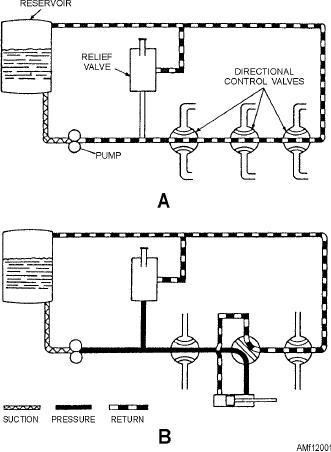
pressure priority by an isolation valve. This design
feature isolates nonessential flight functions and
prevents loss of hydraulic fluid in the event of utility or
normal system rupture.
As a minimum requirement, filters are provided in
each system pressure line, return line, and pump
bypass or case drain line. Where hydraulic sequencing
is critical, each sequence valve is protected from
c o n t a m i n a t i o n i n e a c h d i r e c t i o n o f f l ow b y a
screen-type filter. The filter is usually included as a
part of the sequence valve. The pressure line filters
clean all fluids before they enter any major equipment.
If there are only two hydraulic systems, the primary
system is known as the No. 1 power control system
(PC-1). The system supplying the other half of the
flight control tandem actuating mechanisms and the
utility hydraulic system is known as PC-2. The PC-2
system is also known as the combined hydraulic
system. If there are three hydraulic power systems,
they are generally identified as PC-1, PC-2, and utility
system. Some manufacturers label the utility system
PC-3. Each system has its own reservoir, hydraulic
Figure 12-1.--Basic open-center hydraulic system.
pump(s), and plumbing.
Military specifications, MIL-H-5440 (series),
back to the reservoir until one of the selector valves is
provide complete design, installation, and data
positioned to operate a mechanism.
requirements for aircraft hydraulic systems. These
When one of the selector valves is positioned to
s p e c i fi c a t i o n s p r ov i d e r e f e r e n c e t o a l l o t h e r
operate an actuating device, fluid is directed from the
specifications concerning aircraft hydraulic systems.
pump through one of the working lines to the actuator.
Items such as hose assemblies, hose support
See view B of figure 12-1. With the selector valve in
requirements, minimum bend radii, types of pumps,
this position, the flow of fluid through the valve to the
and types and classes of systems are found in the
reservoir is blocked. The pressure builds up in the
specifications.
system to overcome the resistance and moves the
piston of the actuating cylinder. The fluid from the
Many maintenance instruction manuals (MIMs)
opposite end of the actuator returns to the selector
refer to aircraft hydraulic systems as being open-center
valve and flows back to the reservoir. Operation of the
or closed-center systems.
system following actuation of the component depends
on the type of selector valve being used.
Open-Center System
Several types of selector valves are used in
An open-center system is one having fluid flow,
conjunction with the open center system. One type is
but no pressure in the system when the actuating
both manually engaged and manually disengaged.
mechanisms are idle. The pump circulates the fluid
First, the valve is manually moved to an operating
from the reservoir, through the selector valves, and
position. Then, the actuating mechanism reaches the
back to the reservoir. See view A of fig 12-1. The open
end of its operating cycle, and the pump output
center system may employ any number of subsystems,
continues until the system relief valve relieves the
with a selector valve for each subsystem. Unlike the
pressure. The relief valve unseats and allows the fluid
closed center system, the selector valves of the open
to flow back to the reservoir. The system pressure
center system are always connected in series with each
remains at the relief valve set pressure until the selector
other. In this arrangement, the system pressure line
valve is manually returned to the neutral position. This
goes through each selector valve. Fluid is always
action reopens the open center flow and allows the
system pressure to drop to line resistance pressure.
allowed free passage through each selector valve and
12-2

